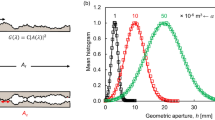Abstract
The spacing of opening-mode fractures in layered materials—such as certain sedimentary rocks and laminated engineering materials—is often proportional to the thickness of the fractured layer1,2,3,4. Experimental studies of this phenomenon1,5 show that the spacing initially decreases as extensional strain increases in the direction perpendicular to the fractures. But at a certain ratio of spacing to layer thickness, no new fractures form and the additional strain is accommodated by further opening of existing fractures: the spacing then simply scales with layer thickness, which is called fracture saturation5,6. This is in marked contrast to existing theories of fracture, such as the stress-transfer theory7,8, which predict that spacing should decrease with increasing strain ad infinitum. Recently9,10, two of us (T.B. and D.D.P.) have used a combination of numerical simulations and laboratory experiments to show that, with increasing applied stress, the normal stress acting between such fractures undergoes a transition from tensile to compressive, suggesting a cause for fracture saturation. Here we investigate the full stress distribution between such fractures, from which we derive an intuitive physical model of the process of fracture saturation. Such a model should find wide applicability, from geosciences11,12,13,14 to engineering1,2,6,15,16.




Similar content being viewed by others
References
Garrett, K. W. & Bailey, J. E. Multiple transverse fracture in 90° cross-ply laminates of a glass fibre-reinforced polyester. J. Mater. Sci. 12, 157–168 (1977).
Parvizi, A. & Bailey, J. E. On multiple transverse cracking in glass fibre epoxy cross-ply laminate. J. Mater. Sci. 13, 2131–2136 (1978).
Narr, N. & Suppe, J. Joint spacing in sedimentary rocks. J. Struct. Geol. 13, 1037–1048 (1991).
Gross, M. R. The origin and spacing of cross joints: examples from Monterey Formation, Santa Barbara Coastline, California. J. Struct. Geol. 15, 737–751 (1993).
Wu, H. & Pollard, D. D. An experimental study of the relationship between joint spacing and layer thickness. J. Struct. Geol. 17, 887–905 (1995).
Aveston, J., Cooper, G. A. & Kelly, A. The Properties of Fiber Composites 15 (IPC Sci. Technol. Press, London, 1971).
Cox, H. L. The elasticity and strength of paper and other fibrous materials. Br. J. Appl. Phys. 3, 72–79 (1952).
Hobbs, D. W. The formation of tension joints in sedimentary rocks: an explanation. Geol. Mag. 104, 550–556 (1967).
Bai, T. & Pollard, D. D. Fracture spacing in layered rocks: a new explanation based on the stress transition. J. Struct. Geol. 22, 43–57 (2000).
Bai, T. & Pollard, D. D. Spacing of fractures in a multilayer at fracture saturation. Int. J. Fract. (in the press).
Price, N. J. Fault and Joint Development in Brittle and Semi-Brittle Rocks 176 (Pergamon, Oxford, 1966).
Pollard, D. D. & Aydin, A. Progress in understanding jointing over the past century. Geol. Soc. Am. Bull. 100, 1181–1204 (1988).
National Research Council Rock Fractures and Fluid Flow: Contemporary Understanding and Applications 551 (National Academy Press, Washington DC, 1996).
Whittaker, B. N., Gaskell, P. & Reddish, D. J. Subsurface ground strain and fracture development associated with longwall mining. Mining Sci. Technol. 10, 71–80 (1990).
Thouless, M. D., Olsson, E. & Gupta, A. Cracking of brittle films on elastic substrates. Acta Metall. Mater. 40, 1287–1292 (1992).
Hong, A. P., Li, Y. N. & Bazant, P. Theory of crack spacing in concrete pavements. J. Eng. Mech. 123, 267–275 (1997).
Lachenbruch, A. H. Depth and spacing of tension cracks. J. Geophys. Res. 66, 4273–4292 (1961).
Hu, M. S. & Evans, A. G. The cracking and decohesion of thin films on ductile substrates. Acta Metall. 37, 917–925 (1989).
Thouless, M. D. Some mechanics for the adhesion of thin films. Thin Solid Films 181, 397–406 (1989).
Thouless, M. D. Crack spacing in brittle films on elastic substrates. J. Am. Ceram. Soc. 73, 2144–2146 (1990).
Timoshenko, S. P. & Goodier, J. N. Theory of Elasticity 3rd edn, 567 (McGraw-Hill, New York, 1970).
Wawrzynek, P. A. & Ingraffea, A. R. Interactive finite element analysis of fracture processes: An integrated approach. Theor. Appl. Fract. Mech. 8, 137–150 (1987).
Acknowledgements
We thank A. Aydin, M. Gross, G. Mavko and Y. Yue for discussions and suggestions. This work was supported by the Stanford RFP and the US NSF.
Author information
Authors and Affiliations
Rights and permissions
About this article
Cite this article
Bai, T., Pollard, D. & Gao, H. Explanation for fracture spacing in layered materials. Nature 403, 753–756 (2000). https://doi.org/10.1038/35001550
Received:
Accepted:
Issue Date:
DOI: https://doi.org/10.1038/35001550
- Springer Nature Limited
This article is cited by
-
Development of craquelure patterns in paintings on panels
Heritage Science (2024)
-
Mechanical and Volumetric Fracturing Behaviors of Layered Composite Sandstones with a Contrast in Grain Size Under True Triaxial Stresses
Rock Mechanics and Rock Engineering (2024)
-
Interpretation of geometrical characteristics of joints using drill core
Geosciences Journal (2024)
-
Initiation and Propagation of Interface Cracks in Layered Composite Rocks: An Investigation Using True Triaxial Experiments
Geotechnical and Geological Engineering (2024)
-
Strain-Induced Damageability of Elastic-Plastic Carbon Nanocoatings on a Polymer Substrate
Russian Physics Journal (2023)





